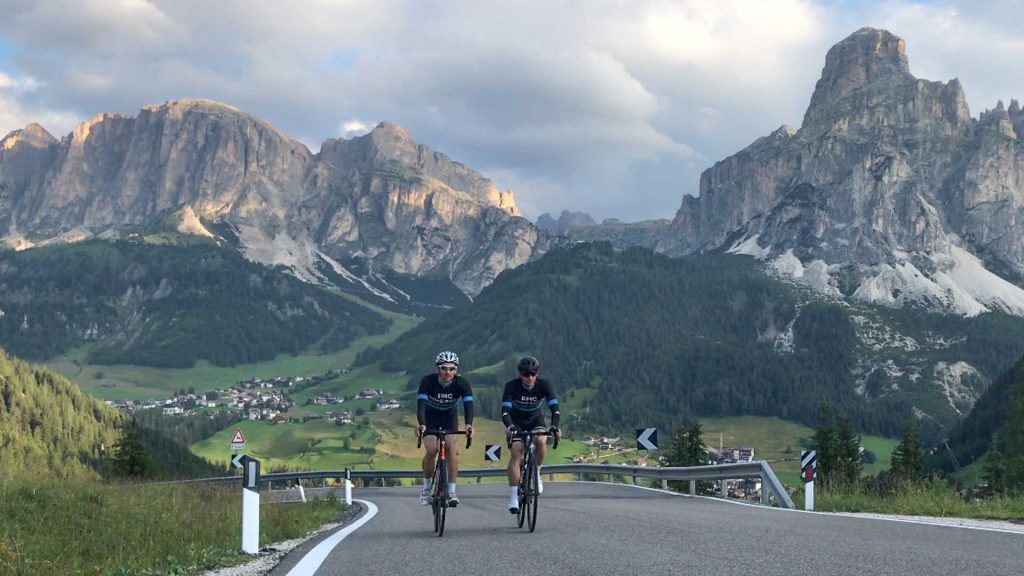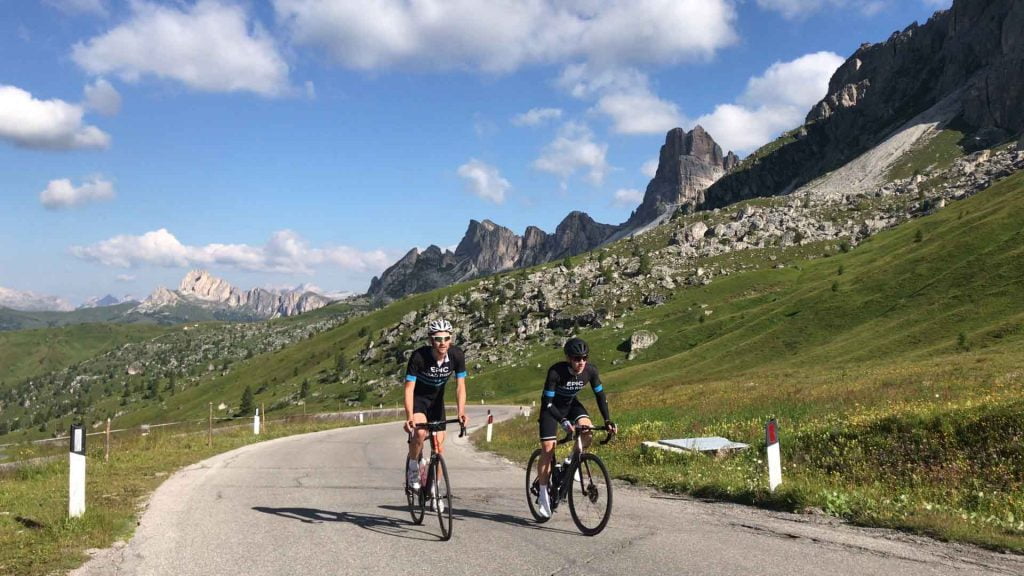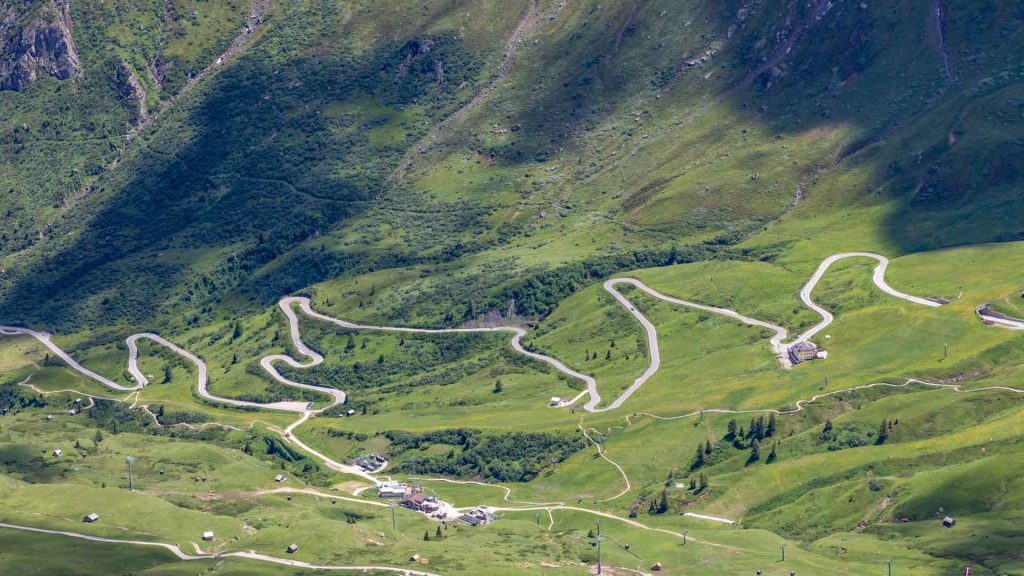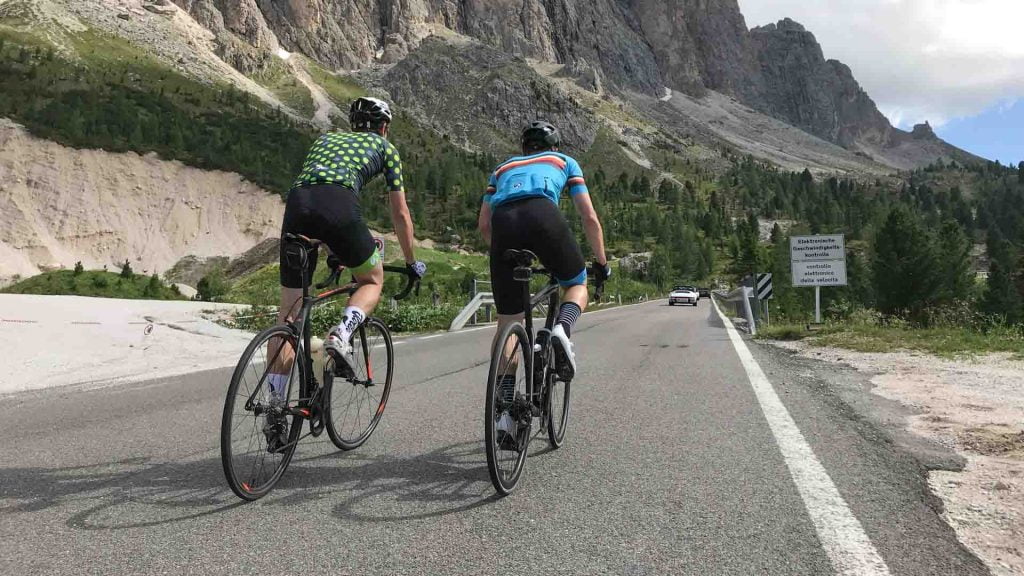Road cycling the Dolomites of Italy is unlike cycling anywhere else in the world.
If you’re fit and can climb, you need to visit, end of story.
Read on to plan your Dolomites cycling holiday…
In this guide, you’ll find everything you need to plan an unforgettable Dolomites cycling holiday: detailed information on the best road rides in the Dolomites plus where to stay in the Dolomites, information on weather in the Dolomites and the best time to visit for cyclists plus Dolomites bike hire.
Read on and plan your next cycling holiday in the Dolomites.
Looking for more leisurely Dolomites cycling routes? Our guide to the Northeast of Italy also covers the key cycling regions to consider, including more leisure cycling ideas.
The most beautiful natural architecture worldwide
Le Corbusier
Overview of the Dolomites (for cyclists)
What’s so special about cycling the Dolomites?
1. The scenery
When cycling in the Dolomites, you’ll soon discover that the UNESCO-protected scenery is mind-blowing. Vast limestone peaks rise up vertically around you, with the roads weaving their way through the steep-sided valleys flanked by towering turrets of rock.
The scenery here has an intensity we haven’t seen anywhere else we’ve ridden. It’s as if the mountains are on steroids. Yes the French and Italian Alps also have massive mountains, but here it feels like you could just spread out your arm and touch them. It’s almost otherworldly. No surprise then that road cycling in the Dolomites is number 1 in our pick of the best places for cycling in Italy.
2. The climbs
Expect to suffer on many of the classic Dolomites climbs. While the distances of some of the climbs we’ve written about below might not sound earth-shattering, conquering a 2.7 km stretch of the Passo Fedaia with a 10-15% gradient will feel like a pretty huge feat while you’re struggling through it.
3. The heritage
The Dolomites mountains are also alive with road cycling heritage. The Giro d’Italia first visited in 1937 and has been back over 40 times. Famous Italian cyclists (names like Bartali, Coppi and Binda) first curated their reputations when riding a bike in the Dolomites.
Unsurprisingly, the Dolomites are no undiscovered gem. The region is hugely popular with cyclists and each year there are two famous Dolomites cycling events: the Sella Ronda Bike Day (20,000 cyclists, closed roads) and Maratona dles Dolomites (July, 9,000 cyclists, closed roads).
Cycling the Dolomites on closed roads isn’t something we’ve had the opportunity to sample firsthand – but we think it would be fantastic. The narrow, twisting roads get very busy in the short summer months when the passes are open to cyclists (and there aren’t bike paths/shoulders to ride on). So biking in the Dolomites on closed roads, without cars, would be amazing. There’s more on the Sella Ronda Bike Day and Maratona dles Dolomites below.
Where are the Dolomites?
The Italian Dolomites are found in northern Italy. The border with Austria is to the north and the Venetian plain lies to the south. The mountains – part of the Southern Limestone Alps – are spread across three Italian regions: Trentino, Veneto and Alto Adige. They are part of the provinces of Belluno, Bolzano, Trento, Udine and Pordenone.
The mountains cover an area of about 90 km north to south and 100 km east to west. They are made up of 15 different ranges, each of which is at around 3,000 metres high. In this guide we concentrate on the best cycling routes in the Dolomites. This covers a relatively small part of the area – the part that has been made famous to cyclists via the Giro d’Italia and the Maratona dles Dolomites.
For details on how to get to the Dolomites, see the Tips section below. For information on the best places to stay in the Dolomites for cyclists, see the Where to Stay section.
The Dolomite Alps in the Italian Alps
It’s worth mentioning that while the Dolomites are in the Italian Alps, they are separate to the Bormio region (with the famous Stelvio, Mortirolo and Gavia climbs). That region is 200km to the west of the Dolomites, in the Italian province of South Tyrol.
Confusingly, you’ll often come across people referring to the Stelvio, Mortirolo and Gavia as being in the Dolomites – but they’re not! So don’t come to cycle the Dolomites if you’re expecting to conquer those passes.
What to expect from the Dolomites
The first thing to say regarding Dolomites biking is that there really isn’t much flat terrain around here. If you look at a Dolomites road map, you’ll soon see that the mountains are so steep, and most of the valleys are so narrow, that there aren’t a huge number of roads to choose from. As such, road cycling in the Dolomites is not a good choice for beginners – or those that haven’t done much training!
We mentioned in the introduction that the scenery is quite different to other mountainous areas we’ve visited. Likewise, the names of the climbs have a rolling beauty that’s quite distinctive: there’s a lyrical elegance to the Passo Campolongo, Passo Falzarego, Passo Valparola for example.
Dolomites cycling climbs and routes
Dolomites cycling climbs
Here are our reviews of the classic Dolomite climbs. The most famous climbs of the area are probably those on the Sella Ronda (the Gardena, Sella, Campolongo and Pordoi).
The additional climbs that make up the Maratona course are the Giau and Falzarego/Valparola.
Finally you could include the Fedaia as part of your Dolomites Italy cycling holiday. It’s famous for its fearsome gradients.
Rides
Dolomites cycling routes
When biking in the Dolomites, we would suggest giving the Sella Ronda route a go as it covers four of the most famous passes in a neat loop.
Taking on the Maratona loop is a more audacious challenge. If you’re based somewhere convenient, you could always split this loop over two days.
Finally, this loop of Passo della Erbe and the Funes Valley is among the best bike rides in the Dolomites, but we haven’t yet had a chance to write a full guide to it. Once you’re away from the main SS244 at San Martino, it’s a stunning ride and much less known than other roads in the area. We found it beautifully quiet when we rode it.
The 4 best cycling routes in the Dolomites are also worth considering. Our in-depth guide to cycle route planning may be useful if you want to find some additional routes.
If you want support with your trip, check out our article on Italy’s best bike tours.
Dolomites cycling events
Dolomites bike day
The Dolomites Bike Day is a newer event than the better known Sella Ronda Bike Day and Maratona dles Dolomites. It takes place in mid June and, like the Sella Ronda Bike Day, it is a non-competitive bike event that’s free of charge. There’s no requirement to register and the roads are traffic free until early afternoon. The 51km route takes you over the Passo Campolongo, Passo Falzarego and Passo Vaparola.
Sella Ronda Bike Day
This is the biggest Dolomites cycling event on the amateur calendar. Each year, in June and again in September, the roads are closed to traffic and more than 20,000 riders take on the Sella Ronda route. The Sella Ronda Bike Day takes in the four passes of Campolongo, Pordoi, Sella and Gardena.
Maratona dles Dolomites
The Maratona dles Dolomites is a Dolomites cycling tour that comes a month later, in July each year. It attracts around 9,000 cyclists and there are three courses, from 55-138km. There’s a week-long lead up to the event with many riders arriving early for parties and training. Read our Cyclist’s FAQs about the Maratona dles Dolomites for lots more info.
Giro delle Dolomiti
The Giro delle Dolomiti is a five-day amateur cycling event that winds its way 400+ kilometres through the dramatic scenery of the Italian Dolomites in northern Italy. This annual event takes place every July and starts and finishes in the city of Bolzano. The route takes in many Giro d’Italia classics, including the Sellaronda and the Passo dello Stelvio.
Best places to stay in the Dolomites (for cyclists)
To be absolutely honest, we really struggled when it came to finding somewhere nice to use as a base in the Dolomites, Italy.
The main reason for this was probably that we left it too late (we were booking in January for our visit in July) and we were looking for somewhere quite big – a self-catering chalet with four bedrooms. As a result, we ended up staying in the little village of Santa Cristina Val Gardena. The accommodation was fine, but the location was not ideal. As a result, and unusually for us, we aren’t sharing the details of where we stayed in this guide.
In terms of the kind of accommodation you can expect to stay in, our experience was that it’s more rustic Alpine chalet than boutique hotel. So we’d suggest setting your expectations accordingly and you won’t be disappointed.
In this article we share our pick of the best bike hotels in the Dolomites.
Corvara
If we were to visit again, we would base ourselves in one of the Dolomites bike hotels in Corvara. Corvara is a decent sized town at the bottom of the Passo Gardena, and on the loop of the Sella Ronda.
Focus on the routes…
A final point to note: while the core area of the Dolomites looks relatively small on a map, it takes ages to get anywhere by car or public transport due to the fact there are no flat or straight roads in the region. So picking the right location is really important when it comes to planning Dolomites cycling trips – more so than many other destinations.
Our advice is to focus on how and where you want to ride the Dolomites, and make sure you’re going to be able to access them relatively easily from your accommodation. Otherwise, you’ll run the risk of not doing the rides you wanted – or having to drive to the start of the route.
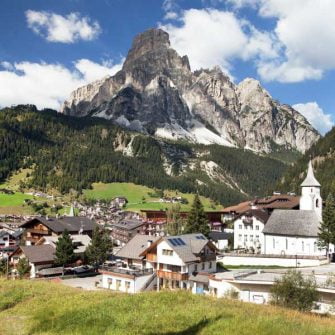 Corvara in Badia (known as Corvara) in the Dolomites
Corvara in Badia (known as Corvara) in the Dolomites Lots of routes start and finish from Corvara
Lots of routes start and finish from Corvara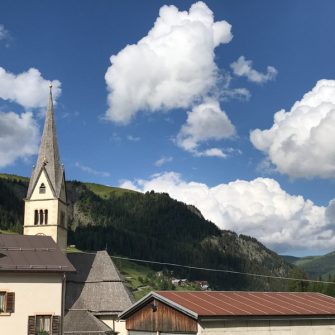 The small village of Arabba
The small village of ArabbaBike hire in the Dolomites
If you’re looking to hire a road bike in the Dolomites, you should be able to find what you’re looking for. However, be aware that there aren’t loads of hire shops so if you’re visiting at a busy time of year or for the Maratona or Sella Ronda bike day, you’ll definitely need to book ahead of your Dolomites road cycling trip. It’s also worth noting that the shops are scattered throughout the local towns, so if you want to hire, bear that in mind when deciding where to stay (it’s always much easier if your bike hire is close to where you’re staying).
While we haven’t done an exhaustive study, we felt hire prices here were quite expensive compared to many destinations. That’s probably due to the fact there isn’t an oversupply of shops that offer it.
We hired a bike from Ski Adolf and were pleased with both the bike and service.
A final point: if you’re looking at the websites for some of the operators below, it may look at first glance as if they’re just a ski hire company. Look a bit closer: most of them offer ski hire in winter and bike hire in summer. The information you’re looking for should be somewhere there – or you can of course always drop them an email. They may also offer Dolomites bike tours.
This information is offered as an indicative guide only: we periodically update it but prices, services and bike brands may change. Please let us know if you find anything that is incorrect.
| Dolomites bike hire shop | Info | Cost |
|---|---|---|
|
Alta Badia Bike Rental
9 Bike Friendly Alta Badia rental shops |
They hire road bikes (and road e-bikes!). You can book online, and may have the option of paying to hire a helmet, GPS and GoPro. | Prices vary by rental outlet |
|
Ski & Bike Armin Via Dursan 108 39047 St. Christina di Val Gardena |
They have electric mountain bikes available to rent. | Adult e-bikes from 56 euros per day |
|
Edoardo Sport Via Pecei 12 Colfosco |
They offer regular and electric mountain bikes, plus kids’ equipment including trailers, seats and bikes. | Adult hardtail mountain bikes from 39 euros per day |
|
Breakout Sport Str. Col Alt, 61 39033 Corvara |
Offer a range of racing bikes, front and full suspension mountain bikes, e-bikes, e-road bikes and kids’ bikes and accessories. Includes Scott, Specialized and Pinarello bikes. | Prices range from 59 to 120 euros per day. |
Tips for hiring a bike in the Dolomites:
- Book your bike in advance, particularly in peak season.
Undecided on whether to hire a bike or bring your own? Read this.
 Front of Bike and Ski Adolf
Front of Bike and Ski Adolf Bikes at Bike and Ski Adolf
Bikes at Bike and Ski AdolfWhen to go
The best months for cycling the Dolomites routes, from a weather perspective, are June to October (and if you can avoid the school holidays in July and August, so much the better). May could also be a good bet, but statistically it’s the region’s wettest month. If you do visit in May, pack some wet weather kit! Rain in the Dolomites falls mainly in spring and autumn.
As ever in the high mountains, remember that the weather can be unpredictable.
| January | The towns you ride through in summer are all ski resorts come winter, so these months are best avoided for those on road bikes. The snow clears by the end of April, marking the transition back to clear roads and cyclists!
|
| February | |
| March | |
| April | |
| May | Temperatures increase but with this also comes rain. If you come at this time of year, expect lush green valleys and lots of wildflowers, but bring a jacket!
|
| June | |
| July | Temperatures should be warm and schools are out. The narrow roads that weave between the vertical peaks are busy with holidaymakers and local tourist traffic. You may also encounter rain, typically in the form of late afternoon thunderstorms. If you’d prefer quieter roads and have the flexibility, avoid these months.
|
| August | |
| September | These months offer a good chance for a late summer adventure, with some great autumn colours. The weather is often stable and clear, though there may be snowfall on the highest slopes when the weather is bad.
|
| October | |
| November | Snow starts to fall and resorts are moving into ski season. These months are best avoided by cyclists.
|
| December |
Source: https://www.dolomitemountains.com/ note these are based on the valley floor in Cortina d’Amezzo
Getting around the Dolomites
We found it essential to have a car when exploring the Dolomites. It makes getting to the start of a ride significantly more convenient.
Sponsor Message
Use the search box below to search, compare and book the best car rental deal for your trip.
Tips
Check out our tips for cycling in the Dolomites here.
Highway code and travel information
As ever, it’s a good idea to check current travel information before you book and travel. For UK visitors, the UK government travel information pages for Italy are here.
You should also read and follow Italy’s highway code.
Cycling books about the Dolomites
A lot has been written about the Dolomites.
We are fans of Friedbe and Goding’s “Mountain High”, which includes write-ups on Passo Fedaia, Passo Giau and Passo Pordoi. You can read our review of Mountain High, here.
We also love browsing Michael Blann’s beautiful “Mountains” coffee table book. There is a section on the Dolomites and you could lose many an hour drooling over the photography and enjoying the stories.
For focus on the Giro d’Italia, Herbie Syke’s Maglia Rosa is the book for you. It’s a weighty tome, but the tales of the Giro really take you behind the scenes and the grainy photos of yesteryear’s cycling legends are incredibly evocative.
Dolomites cycling map
We bought a copy of the Dolomites cycling map sold by Cycling Dolomites. It’s nicely printed (though it’s not laminated so might not last that long if it’s destined for your back pocket), and helpfully includes details of where you can find water fountains. On the back of the map are climb profiles and it comes with five route cards showing the route of the Maratona dles Dolomites over the years. At the time of writing it cost 9,50 euros (plus postage if you have it sent to you).
If you like physical maps and having an overview of the whole area, you’ll like this – but (in our humble opinion), our route guides and GPX files are more useful for planning your Dolomites bike trail discoveries!
How do you get to the Dolomites?
The closest international airport to the Dolomites is the one in Venice. From Venice to the Dolomites (Corvara to be precise), it’s just under 200km, and a 3 hour drive. There are some public transport options, but you’ll need to have time at your disposal.
Many people do what we did before bicycling in the Dolomites. Which was fly into Venice airport, hire a car and then drive. You could then drive on to Bormio, followed by the Italian Lakes, before heading home via the international airport in Milan. Of course, it’s just as feasible to follow this kind of tour in reverse too.
A final note on access: there are other airports near the Dolomites in Italy. Check out flying via the smaller airports of Innsbruck, Verona and Treviso, just in case they work better for you. In particular, Innsbruck is only just over the border in Austria – but if you do take this option and hire a car, make sure the terms of your rental agreement allow you to cross the border!
Evening in the Dolomites
Don’t miss seeing the evening in the Dolomites. At the end of a sunny day, the evening sun catches the imposing faces of the mountains and paints them in a pink, rosy hue. It’s quite spectacular – and a highlight of cycling in northern Italy.
Language in the Dolomites
There is a real mix of ethnic groups and languages in the area. It’s quite common to see signs in Italian, German and sometimes Ladin too. There’s more information on the reasons for this below.
Many of the towns, and sometimes even the mountains, have two names, one in Italian and one in German. Confusingly, they’re usually very different names! For example Corvara is the Italian name, but you may also see it referred to as Kurfar. Likewise it’s Val Gardena in Italian or Gröden in German. We stick with the Italian names in our guides, but it’s worth knowing about this quirk when planning Dolomites cycling holidays!
 Magical evening light in the Dolomites
Magical evening light in the Dolomites Church of San Giovanni in Val di Funes, South Tyrol
Church of San Giovanni in Val di Funes, South Tyrol More spectacular light in the Dolomites
More spectacular light in the DolomitesHistory of the Dolomites
250 million years ago the Dolomites were part of a coral reef – similar to what you’d see if you were diving in the Maldives or the islands of Polynesia. Later, tectonic movements pushed together the areas of today’s Africa and Europe with violent volcanic eruptions and folding that uplifted the area. The sea withdrew exposing the sea bed and the Dolomites emerged. The Ice Age took its hold and sharpened the valleys with glaciers 1,500 metres thick covering the area.
If you look carefully at the rock, in many areas, you can see the horizontal layers of limestone, heavily stratified and folded. These are in fact thick layers of seaweed, coral and tiny organisms that lived in the ancient seas.
The name “Dolomites” comes from the rock’s first official scholar, the French geologist Deodat-Guy-Sylvain-Tancre de Gratet de Dolomieu. He sent samples to Switzerland for classification in 1789. The verdict was that the rock was of an unknown composition and warranted its naming after the “founder”.
Until the First World War, much of the area was Austrian. During the war, the area was a theatre of battle and on the Marmolada there are traces of old trenches. The war resulted in Italy’s annexation of regions, in which Italians and Austrians had previously lived together under the Austrian flag. On 10 September 1919 the people that lived here officially changed from being Austrian citizens to Italian citizens.
The Ladin influence
You’ll see the Ladin (not Latin) influence in everything from the food to the architecture – steep slatted roofs and wooden chalets.
The Ladin language was the major language of the mountains for centuries. It’s still officially spoken by 30,000 people of the four valleys: the Sella, the Val Badia, Val Gardena, the Val di Fassa, the Valle di Livinallongo and the Valle d’Ampezzo.
There’s been a bit of a revival of Ladin recently, and in La Villa in Val Badia, the population is trilingual and even the youngest children speak Italian, German and Ladin. If you want to get a taste of the local culture, don’t miss the Gardena folk festival on the first Sunday in August, with a parade, local bands and the traditional costumes of the various towns. The costumers reflect the Tyrolean influence of the inhabitants.
Legends of the Dolomites
The Dolomites are known to some as the “Monti Pallidi”. This means “the pale rocks”. Legend has it that in ancient times, the dolomitic rocks were the same colour as the Alps, with flower meadows, lakes and forests.
Then one day the King’s son married the moon princess – but unfortunately the King’s son couldn’t stand the intense moon light and the princess couldn’t stand the shadowy woods, so they were destined to be kept apart.
One day the prince ran into a magical gnome who offered to sort things out. He wove moonlight around the Dolomites so that the princess could come down from the moon to live in the Dolomites with the prince.
From then on the Dolomites were named Monti Pallidi and people say the white edelweiss flowers in the meadows are the princess’ gifts from the moon.
There’s more on legends of the Dolomites here.
Other useful information
If you’re not too pushed for time, while you’re in this part of the world you might like to take a day trip to Treviso, which is home to big cycling industry names including Pinarello, Sidi, Campagnolo, Selle Italia and Fizik.
Enjoyed our guide to cycling the Dolomites?
We’d love to hear from you – comment below or drop us a line.
- Want more? Don’t miss our climb guides, listed above and in the articles section below. There’s also our guide to the Maratona, if you feel tempted by that legendary event! You may also find this guide to planning a cycling holiday in Northeast Italy useful.
- Want to take in the Stelvio (and nearby Gavia and Mortirolo) while you’re in the region? Here’s our in-depth guide to the incredible Stelvio region that’s only a couple of hours away from the Dolomites.
- Want to check out some different destinations? How about cycling in the French Alps, the Slovenian Alps or Austrian Alps? Check out other places for a summer cycling holiday or search by the month you want to travel or cycling destination you want to visit, here.
Please support Epic Road Rides
A huge amount of time and effort goes into the article you’ve just read, all with the aim of helping you!
If you found what you’ve read useful, I’d really appreciate it if you dropped something in the tip jar here.
It’s a way you can say thank you and help us carry on creating top quality content with no annoying ads and no pay wall.
Looking for an organised cycling trip?
If you want someone to help you plan and book your cycling holiday, fill out this form. We aren’t a tour operator/agent but we work with lots of people who are and will do our best to put you in touch with someone that can help (within 24 hours where possible)!This article includes details of products and/or services that we have used ourselves or which we would consider using. Some are paid features or include affiliate links or referral codes which we may earn commission from. As an Amazon Associate we earn from qualifying purchases. Please read our disclosure policy for further information.
The contents of this website are provided for general information purposes only. It is not intended to amount to advice and you should not rely on it. You should carry out your own due diligence and risk assessments and take professional advice. Views expressed by interviewees or other users of this website do not necessarily represent our views. We make no representations, warranties or guarantees, whether express or implied, that the content on our website is accurate, complete or up to date. If you use any information or content on this website, download from, or otherwise obtain content or services through our website, it is entirely at your own discretion and risk. Epic Road Rides Ltd disclaims all liability and responsibility arising from any reliance placed on the information and content on this website. Find out more here.




